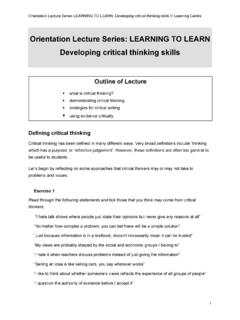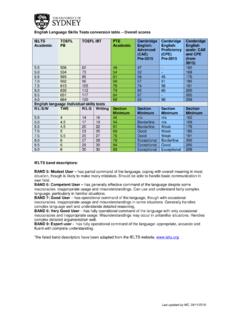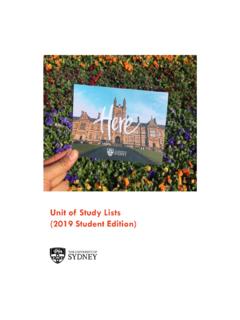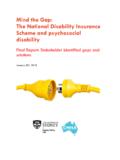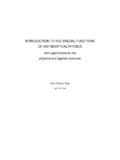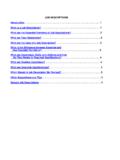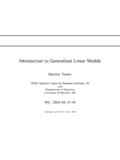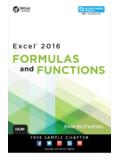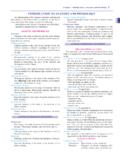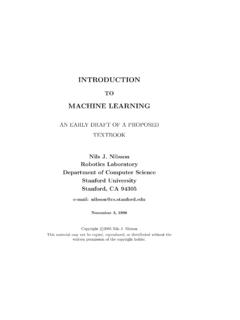Transcription of Introduction to Trigonometric Functions - University of …
1 Introduction toTrigonometric FunctionsJackie NicholasPeggy AdamsonMathematics Learning CentreUniversity of SydneyNSW 2006c 1998 University of SydneyAcknowledgementsA significant part of this manuscript has previously appeared in a version of this bookletpublished in 1986 by Peggy Adamson. In rewriting this booklet, I have relied a great dealon Peggy s ideas and approach for Chapters 1, 2, 3, 4, 5 and 7. Chapter 6 appears in asimilar form in the booklet, Introduction to Differential Calculus, which was written byChristopher her original booklet, Peggy acknowledged the contributions made by Mary Barnes andSue Gordon. I would like to extend this list and thank Collin Phillips for his hours ofdiscussion and NicholasSeptember 1998 Contents1 How to use this booklet .. Objectives .. 12 Angles and Angular Converting from radians to degrees and degrees to radians.
2 Real numbers as radians .. 53 Trigonometric Ratios in a Right Angled Definition of sine, cosine and tangent .. Some special Trigonometric ratios .. 74 The Trigonometric The cosine function .. The sine function .. The tangent function .. Extending the 135 Graphs of Trigonometric Changing the amplitude .. Changing the period .. Changing the mean level .. Changing the phase .. 20iMathematics Learning Centre, University of Sydneyii6 Derivatives of Trigonometric The calculus of Trigonometric 227 A Brief Look at Inverse Trigonometric Definition of the inverse cosine 258 Solutions to Exercises26 Mathematics Learning Centre, University of Sydney11 IntroductionYou have probably met the Trigonometric ratios cosine, sine, and tangent in a right angledtriangle, and have used them to calculate the sides and angles of those this booklet we review the definition of these Trigonometric ratios and extend theconcept of cosine, sine and tangent.
3 We define the cosine, sine and tangent as functionsof all real numbers. These Trigonometric Functions are extremely important in science,engineering and mathematics, and some familiarity with them will be assumed in mostfirst year University mathematics Chapter 2 we represent an angle as radian measure and convert degrees to radiansand radians to degrees. In Chapter 3 we review the definition of the Trigonometric ratiosin a right angled triangle. In Chapter 4, we extend these ideas and define cosine, sineand tangent as Functions of real numbers. In Chapter 5, we discuss the properties oftheir graphs. Chapter 6 looks at derivatives of these Functions and assumes that youhave studied calculus before. If you haven t done so, then skip Chapter 6 for now. Youmay find the Mathematics Learning Centre booklet: Introduction to Differential Calculususeful if you need to study calculus.
4 Chapter 7 gives a brief look at inverse How to use this bookletYou will not gain much by just reading this booklet. Mathematics is not a spectator sport!Rather, have pen and paper ready and try to work through the examples before readingtheir solutions. Doallthe exercises. It is important that you try hard to complete theexercises, rather than refer to the solutions as soon as you are ObjectivesBy the time you have completed this booklet you should: know what a radian is and know how to convert degrees to radians and radians todegrees; know how cos, sin and tan can be defined as ratios of the sides of a right angledtriangle; know how to find the cos, sin and tan of 6, 4and 2; know how cos, sin and tan Functions are defined for all real numbers; be able to sketch the graph of certain Trigonometric Functions ; know how to differentiate the cos, sin and tan Functions ; understand the definition of the inverse functionf 1(x) = cos 1(x).
5 Learning Centre, University of Sydney22 Angles and Angular MeasureAn angle can be thought of as the amount of rotation required to take one straight lineto another line with a common point. Angles are often labelled with Greek letters, forexample . Sometimes an arrow is used to indicate the direction of the rotation. If thearrow points in an anticlockwise direction, the angle is positive. If it points clockwise, theangle is can be measured in degrees or radians. Measurement in degrees is based ondividing the circumference of the circle into 360 equal parts. You are probably familiarwith this method of complete revolution is360 .A straight angle is 180 .A right angle is 90 .Fractions of a degree are expressed in minutes ( ) and seconds ( ). There are sixty secondsin one minute, and sixty minutes in one degree.
6 So an angle of 31 17 can be expressedas 31 +1760= .The radian is a natural unit for measuring angles. We use radian measure in calculusbecause it makes the derivatives of Trigonometric Functions simple. You should try to getused to thinking in radians rather than measure an angle in radians, construct a unit circle(radius 1) with centre at the vertex of the angle. Theradian measure of an angle AOB is defined to be the lengthof the circular arc AB around the definition can be used to find the number of radians corresponding to one Learning Centre, University of Sydney3In a complete revolution, A moves anticlockwise aroundthe whole circumference of the unit circle, a distance of2 . So a complete revolution is measured as 2 is, 2 radians corresponds to 360 .Fractions of a revolution correspond to angles which are fractions of 2.
7 14revolution 90 or 2radians13revolution 120 or2 3radians 16revolution 60 or Converting from radians to degrees and degrees to radiansSince 2 radians is equal to 360 radians = 180 ,1 radian =180 = ,yradians =y 180 ,and similarly1 = 180radians, ,y =y calculator has a key that enters the approximate value of .OABM athematics Learning Centre, University of Sydney4If you are going to do calculus, it is important to get used to thinking in terms of radianmeasure. In particular, think of:180 as radians,90 as 2radians,60 as 3radians,45 as 4radians,30 as should make sure you are really familiar with Real numbers as radiansAny real number can be thought of as a radian measure if we express the number as amultiple of 2 .For example,5 2=2 (1 +14)=2 + 2corresponds tothe arc length of 114revolutions of the unit circle goinganticlockwise from A to ,27 2 =4 2 + 2 corresponds to an arc length of revolutions of the unit circle going Learning Centre, University of Sydney5We can also think of negative numbers in terms of radians.
8 Remember for negative radianswe measure arc lengthclockwisearound the unit example, 16 2 = 2 2 + 2 corresponds to the arc length of approximately of the unit circle going clockwise from Ato are, in effect, wrapping the positive real number line anticlockwise around the unitcircle and the negative real number line clockwise around the unit circle, starting in eachcase with 0 at A, (1,0).By doing so we are associating each and every real number with exactly one point on theunit circle. Real numbers that have a difference of 2 (or a multiple of 2 ) correspond tothe same point on the unit circle. Using one of our previous examples,5 2corresponds to 2as they differ by a multiple of 2 . ExerciseWrite the following in both degrees and radians and represent them on a h. 1i. 2 Note that we do not indicate the units when we are talking about the rest of this booklet, we will be using radian measure only.
9 You ll needto make sure that your calculator is in radian Opposite Mathematics Learning Centre, University of Sydney63 Trigonometric Ratios in a Right Angled TriangleIf you have met trigonometry before, you probably learned definitions of sin , cos andtan which were expressed as ratios of the sides of a right angled definitions are repeated here, just to remind you, but we shall go on, in the nextsection, to give a much more useful Definition of sine, cosine and tangentIn a right angled triangle, the side opposite to theright angle is called thehypotenuse. If we choose oneof the other angles and label it , the other sides areoften calledopposite(the side opposite to ) andad-jacent(the side next to ).For a given , there is a whole family of right angled triangles, that are triangles of differentsizes but are the same each of the triangles above, the ratios of corresponding sides have the same ratioadjacenthypotenusehas the same value for each triangle.
10 This ratio is given a specialname, thecosineof or cos .The ratiooppositehypotenusehas the same value for each triangle. This ratio is thesineof orsin .The ratiooppositeadjacenttakes the same value for each triangle. This ratio is called thetangentof or tan .Summarising,cos =adjacenthypotenuse,sin =oppositehypotenuse,tan = 3 CBDZ11 2 /4 /4 XYMathematics Learning Centre, University of Sydney7 The values of these ratios can be found using a calculator. Remember, we are working inradians so your calculator must be in radian ExerciseUse your calculator to evaluate the following. Where appropriate, compare your answerswith the exact values for the special Trigonometric ratios given in the next Some special Trigonometric ratiosYou will need to be familiar with the Trigonometric ratios of 6, 3and ratios of 6and 3are found with the aid of an equilateral triangle ABC with sides oflength 2.
